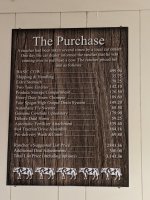I don't think you want to use Vulx in a hempy. Maybe with Coco but I can't see it holding, at all, in perlite. I suspect within a couple of waterings, all the Vulx would be in the res. Keep in mind, Vulx is essentially a rock dust product in a very fine powdered form.
I had given thought to the
likelihood near certainty that at least the majority of it would end up in the reservoir (although I do not buy "big and chunky" perlite). Some of those thoughts:
The reservoir's only practical exit is at the top (of the reservoir). I do not water to runoff
every time. Even when I do, I do not water at the same flow rate that a firehose has

. Assuming that the product does not float, much of it should remain in the reservoir.
And the reservoir is where the nutrients are, the water is, the most active roots are...
With the suggested application rate being quite low, unless the sample size being sent comes in a thimble, there should be enough for more than one application. Although I do not believe that I would have any reason to
routinely reapply the product... With several small hempy setups, I should be able to run one control plant, one single application, and one with multiple applications. Perhaps even more - again, I have not had any discussion with the company representative in regards to sample size. If it's large enough, I will use it in the aforementioned (excepting the control plant(s)) along with soil setups and
possibly even in a DWC (I use a mag drive aquarium power head for the bulk of my aeration, and am not at all concerned about pump damage due to this product; the water input/output is relatively large, and the only filter is at the end of the air line which only "sees" air. I used the last one for five years and it was still working when I gave it away - and this one has never been out of the box...). The DWC would have to be in a later grow, though (finite grow space).
I occasionally do things... somewhat differently than the average person does. Much of the reason for that is being poor and needing to cut costs (and the occasional corner

). But there's also the fact that, in some ways, I am like a (nearly) 50-year old child when it comes to experimentation, gadgets, and wondering, "What if..." Here's a thing: Some time ago, a really good friend decided to send me a quantity of cannabis - and she was feeling
very charitable. But she decided to throw a few fossils into the box for "ballast." I do believe that I enjoyed receiving the fossils even more than I enjoyed receiving the cannabis (and I'm a "fiend"). So this ought to be fun, even if the result ends up being "Yep, you were correct - this product does not provide any noticeable benefit when used in a hempy setup and should not be marketed for that purpose." Plus... At that point in time, the people at the company will
know one way or the other, instead of merely being able to make an informed guess. Experimentation does not need to produce a positive result in order to produce a
beneficial result.
I do have an ulterior motive <SHH!!! (lol) >. I'm hoping that the company representative (et al) will be so intrigued by the possibility of it having at least some benefit to the hempy grower that he(?) will be feeling especially kind when he(?) packs the box for shipment, and ends up throwing in a little extra to do with what I will. Instead of a traditional in-ground food garden this year, I just grew several types of pepper and some tomato plants in rather small pots. The peppers did okay. Frankly, for the container size, I felt that they were good producers. The tomatoes... not so much (I did not place enough thought into strain selection, IMHO). I feel that they would have performed better if there had been a way to cause the plants to require less water and nutrients. It would be awesome if there was a little bit of the Vulx amendment left over next Spring to try in some container fruit plants. <SHRUGS> If not, no worries!
And that brings me to the final portion of this ramble:
IF this product is able to provide any real benefit to the hempy grower, it seems like that would be wonderful. Hempies are generally perlite (only) grows, or else perlite makes up the bulk of the medium. It has ZERO buffering ability. Ergo, anything that can help provide any kind of pH buffering would be great; the hempy style of growing has been called the "lazy grower's best friend," so not having to be quite so anal about pH would be a plus. Reduce water requirements? It's a hydroponic growing method, lol - 'nuff said. Reduce nutrient requirements? Always a good thing. Increase yield? Ditto. So it is worth trying, IMHO.
 ) already has rock dust in the amendments!
) already has rock dust in the amendments! 
 ) already has rock dust in the amendments!
) already has rock dust in the amendments! 



 . Assuming that the product does not float, much of it should remain in the reservoir. And the reservoir is where the nutrients are, the water is, the most active roots are...
. Assuming that the product does not float, much of it should remain in the reservoir. And the reservoir is where the nutrients are, the water is, the most active roots are... .
.